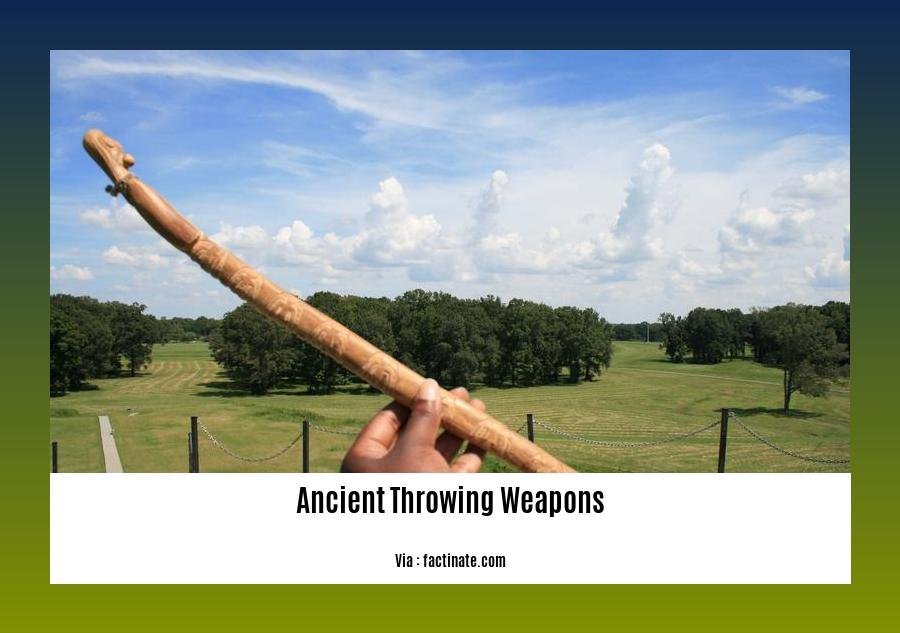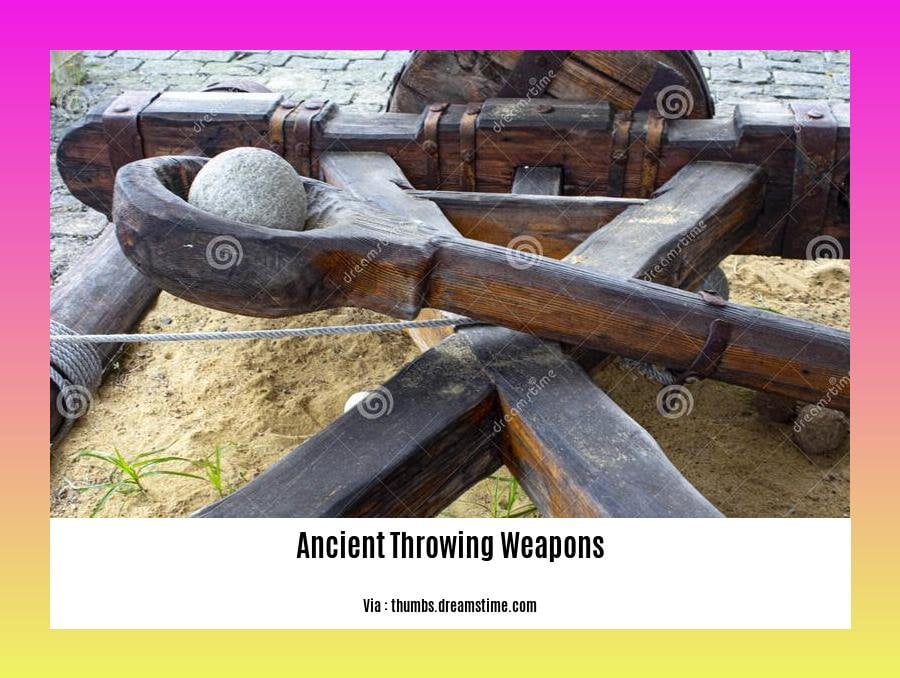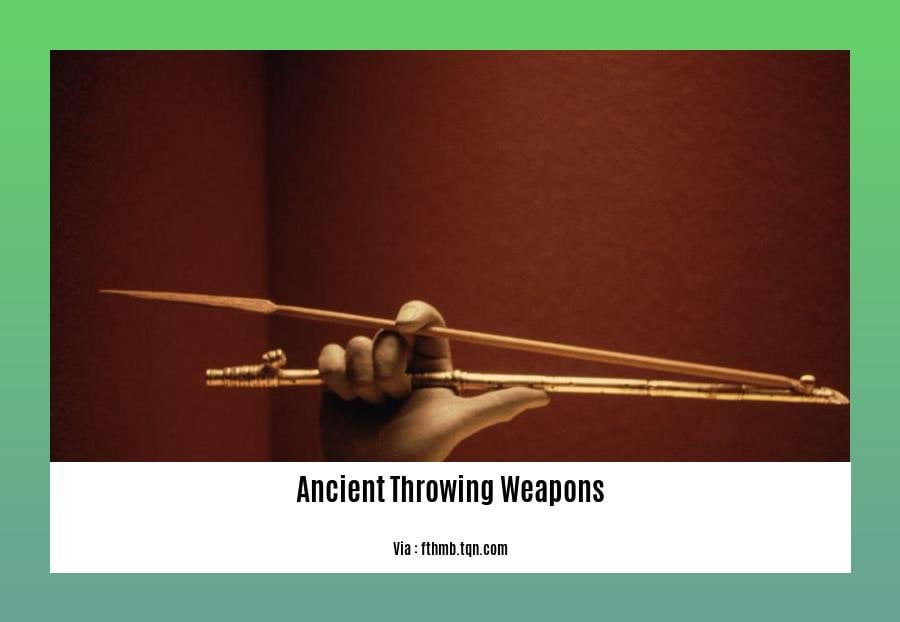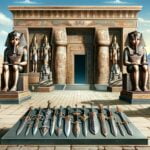Embark on a captivating journey through the annals of warfare as we delve into the realm of [- Ancient Throwing Weapons: Unveiling the History, Significance, and Impact of Ancient Projectiles]. From the earliest spear-throwers to the deadly boomerangs, discover the evolution and mastery of these ranged weapons that shaped the course of history.
Key Takeaways:
-
Throwing weapons like darts, knives, axes, stars, and javelins were used in hunting, warfare, and self-defense throughout history.
-
Throwing weapons predate the bow and arrow and have been featured in art, literature, and mythology across cultures.
-
Ancient throwing weapons were diverse in form and function, ranging from small darts to long spears.
-
Examples of notable ancient throwing weapons include the “Glaze,” “Terror of the Talon,” “Nemo,” and “Peep.”
-
Throwing weapons offer insights into the lives, struggles, and triumphs of our ancestors.
Ancient Throwing Weapons: A Glimpse into the Past

Historical Significance of Ancient Throwing Weapons:
- Among the earliest ranged weapons, predating the bow and arrow, ancient throwing weapons were pivotal in hunting and combat.
- Their use can be traced back to the Stone Age, with evidence of sharpened rocks and bones employed as projectiles.
- These weapons have been immortalized in art, literature, and mythology across cultures, attesting to their profound impact on human history.
Types of Ancient Throwing Weapons:
- Darts: Small, pointed projectiles thrown by hand or with a blowpipe, often used for hunting small game and birds.
- Knives: Specially designed for throwing, featuring balanced blades and optimized grips for accuracy and distance.
- Axes: Throwing axes, often crafted from stone, bronze, or iron, were formidable weapons in both hunting and warfare.
- Stars: Flattened, often spiked projectiles akin to throwing knives, used for both hunting and combat.
- Thorns and Needles: Small, sharp objects, often coated with poison, used for surprise attacks or concealed carry.
- Throwing Clubs/Sticks: Weighted clubs or sticks optimized for throwing, employed in hunting and close-quarters combat.
- Javelins and Spears: Long, pointed weapons designed for throwing at a distance, commonly used in warfare and hunting large game.
- Hand Arrows: Short arrows intended to be thrown by hand, often used in hunting and skirmishes.
- Flying Forks: Rare and specialized throwing weapons with pronged tips, used for hunting and warfare.
Evolution of Ancient Throwing Weapons:
- The evolution of ancient throwing weapons closely mirrored technological advancements and cultural changes.
- Stone Age peoples fashioned basic darts and spears from sharpened rocks and animal bones, gradually refining their designs over time.
- The advent of metalworking led to the development of bronze and iron throwing weapons, offering greater durability and lethality.
- As civilizations developed, so did the sophistication of their throwing weapons, with specialized designs emerging for specific purposes and combat styles.
Cultural Significance of Ancient Throwing Weapons:
- Ancient throwing weapons often held cultural and symbolic significance beyond their practical use.
- In many cultures, they were associated with gods, heroes, and mythical creatures, reflecting their power and importance in warfare and hunting.
- Throwing weapons were often intricately decorated with carvings, engravings, or precious metals, showcasing the artistry and craftsmanship of their makers.
- Their depiction in art, literature, and folklore highlights their cultural significance and enduring fascination.
ancient tattoo methods were painful and complicated procedures that required great skill and patience.
Design, Materials, and Making Techniques

Have you ever wondered how ancient warriors hurled weapons with deadly accuracy? From sleek javelins to menacing axes, the design, materials, and making techniques of ancient throwing weapons were as diverse as the civilizations that wielded them. Let’s delve into the fascinating world of these ancient projectiles.
Key Takeaways:
- Ancient throwing weapons were crafted from readily available materials like stone, bone, wood, and metal.
- Their designs evolved over time, reflecting advancements in technology and combat strategies.
- Craftsmanship played a crucial role in ensuring the effectiveness and durability of these weapons.
- Specialized techniques were employed to shape and sharpen the weapons for optimal performance.
- The cultural significance of these weapons often influenced their design and ornamentation.
1. Materials and Their Significance:
Ancient artisans utilized a range of materials to fashion throwing weapons, each with its unique properties.
-
Stone: The earliest throwing weapons were crafted from sharpened rocks, offering a balance of weight and sharpness. Flint, obsidian, and chert were commonly used for their superior flaking qualities.
-
Bone: Animal bones provided a lightweight yet sturdy material for making throwing weapons. They were often shaped into points, darts, and barbed projectiles.
-
Wood: Wooden spears, javelins, and clubs were widely used due to their abundance and ease of shaping. Hardwoods like oak and ash provided strength and durability.
-
Metal: The discovery of metallurgy brought about a revolution in throwing weapon design. Bronze and later iron were used to create more robust and lethal weapons with sharper edges and longer ranges.
2. Design and Functionality:
The design of ancient throwing weapons was intricately linked to their functionality.
-
Javelins: These long, slender spears were designed for distance and accuracy. Their aerodynamic shape and weighted tips ensured a stable flight path and maximum impact.
-
Axes: Throwing axes were crafted with a balanced design, featuring a sharp blade and a weighted head for increased momentum and penetration.
-
Knives: Throwing knives were designed for precision and stealth. Their sharp blades and ergonomic grips allowed for controlled throws and silent kills.
3. Crafting Techniques and Expertise:
The creation of ancient throwing weapons required specialized techniques and expertise.
-
Stone Knapping: Stone weapons were shaped using a technique called knapping, where skilled artisans used a hammerstone to chip away at the rock, creating sharp edges and points.
-
Bone Working: Bone weapons were crafted using a combination of cutting, scraping, and polishing techniques. Artisans used tools made from stone, bone, or metal to shape and sharpen the bones.
-
Woodworking: Wooden weapons were fashioned using a variety of woodworking techniques, including carving, shaping, and hardening. Artisans used axes, adzes, and chisels to create the desired form and finish.
-
Metalworking: Metal weapons were produced through a process of smelting, forging, and tempering. Smiths used furnaces to melt the metal, hammers to shape it, and quenching techniques to harden the blades.
4. Cultural Influences and Symbolism:
The design and ornamentation of ancient throwing weapons were often influenced by cultural and symbolic factors.
-
Mythology and Religion: Many ancient cultures associated throwing weapons with gods, heroes, and mythical creatures. These weapons were often decorated with symbols and motifs representing these entities.
-
Social Status: In some cultures, the possession and use of certain throwing weapons were restricted to specific social classes or warriors. These weapons symbolized power, authority, and prestige.
-
Artistic Expression: Throwing weapons were sometimes adorned with intricate designs, patterns, and engravings. These decorations showcased the artistry and craftsmanship of the weapons’ makers.
As we journey through the annals of history, the design, materials, and making techniques of ancient throwing weapons offer a glimpse into the ingenuity and skill of our ancestors. These weapons were not just tools of war but also reflections of cultural beliefs, technological advancements, and the indomitable spirit of humankind.
Sources:
- Ancient Weapons: A Journey Through History
- The Art of Ancient Weaponry
Usage and Techniques in Hunting, Warfare, and Sports
Key Takeaways:
-
Hunting: Throwing weapons were crucial tools, extending the hunter’s reach and enabling accurate strikes from a distance, making hunting safer and more efficient.
-
Warfare: In ancient battles, throwing weapons were versatile and deadly, used for both ranged attacks and close-quarters combat, their ability to inflict damage from afar proved advantageous in various warfare tactics.
-
Sports: Throwing weapons found their place in ancient sports and recreational activities, showcasing skill, accuracy, and strength. They were often used in competitive games, testing the limits of human physical abilities.
Ancient throwing weapons:
Hold a captivating allure for history enthusiasts like myself, revealing tales of hunting prowess, fierce battles, and competitive spirits. From humble beginnings to intricate designs, these weapons offer a glimpse into the resourcefulness and ingenuity of our ancestors.
Their utilization spanned various domains:
– Hunting: Sharpened spears and darts provided early humans with a means to strike prey from a distance, maximizing their chances of securing sustenance. It was a dance of skill, timing, and precision, where the hunter’s livelihood depended on the accuracy of their throw.
-
Warfare: The battlefield witnessed an array of throwing weapons, each tailored for specific combat scenarios. Javelins soared through the air, carrying deadly messages of destruction. Axes spun, cleaving through shields and armor. These weapons brought a sense of awe and terror to ancient warfare.
-
Sports: Throwing weapons weren’t just instruments of war and hunting; they also played a role in ancient sports. The thrill of the hunt was recreated in competitive arenas, where skilled athletes displayed their prowess in throwing spears, darts, and other projectiles. It was a spectacle of skill, determination, and sportsmanship.
Conclusion:
From the hands of ancient hunters to the battlefields of mighty warriors, and even in the arenas of sports, throwing weapons have left an indelible mark on human history. Each throw carried a purpose, a story, and an emblem of human resilience. As we delve into the world of ancient throwing weapons, we gain a profound respect for our ancestors’ ingenuity, courage, and love for the thrill of the chase.
Cultural Significance and Symbolism of Ancient Throwing Weapons
The cultural significance and symbolism of ancient throwing weapons are multifaceted and offer a window into the cultural beliefs, practices, and values of ancient societies. These weapons, which predate the bow and arrow, were more than just tools for hunting and warfare; they often held deep cultural and symbolic meanings.
- Symbol of Strength and Prowess:
-
Throwing weapons were often associated with strength, skill, and courage in ancient cultures. Skilled individuals who excelled in throwing these weapons were revered and respected.
-
Objects of Power and Authority:
-
Some throwing weapons were seen as symbols of power and authority. Rulers and military leaders often carried ceremonial throwing weapons to signify their status and authority.
-
The Right of Passage:
-
In certain cultures, learning to use throwing weapons was considered a rite of passage for young men. Mastering these weapons demonstrated a warrior’s readiness to defend his community.
-
Religious and Ritualistic Use:
-
Throwing weapons were sometimes used in religious ceremonies and rituals. They might be offered as gifts to deities or used in symbolic acts of purification or sacrifice.
-
Decorative and Artistic Merit:
-
Many ancient throwing weapons were intricately crafted and decorated with elaborate designs. This showcased the artistic skills of the craftspeople and added to the weapon’s cultural value.
-
Symbolism in Art and Literature:
- Throwing weapons frequently appeared in ancient art, literature, and mythology. They were often depicted in scenes of battle, hunting, or heroic feats, symbolizing various aspects of human experience.
These are just a few examples of how ancient throwing weapons carried cultural significance and symbolism in ancient societies. By understanding these deeper meanings, we gain a richer appreciation for the historical context and cultural heritage of these remarkable artifacts.
Key Takeaways:
- Cultural Significance:
- Ancient throwing weapons held deep cultural significance, symbolizing strength, skill, power, and authority.
-
They were sometimes used in rites of passage, religious ceremonies, and artistic representations.
-
Symbolism:
-
Throwing weapons often carried symbolic meanings, representing various aspects of human experience, such as courage, honor, and the struggle between good and evil.
-
Historical Context:
- Understanding the cultural significance and symbolism of ancient throwing weapons provides a deeper appreciation for the historical context and cultural heritage of these artifacts.
Citations:
FAQ
Q1: What is the historical significance of ancient throwing weapons?
A1: Throwing weapons were the first ranged weapons, preceding the bow and arrow. They have been utilized in hunting, warfare, and self-defense throughout history, leaving an enduring mark on human culture and societal development.
Q2: What are the different types of ancient throwing weapons?
A2: Ancient civilizations employed a wide array of throwing weapons, including spears, knives, axes, stars, thorns, needles, throwing clubs/sticks, javelins/spears, hand arrows, and flying forks. Each type varied in design, purpose, and effectiveness, reflecting the ingenuity and resourcefulness of our ancestors.
Q3: Were ancient throwing weapons effective in warfare?
A3: Ancient throwing weapons played a crucial role in warfare, serving as both offensive and defensive tools. Their ability to strike from a distance, surprise opponents, and inflict significant damage made them formidable weapons in close combat and ranged attacks.
Q4: Do ancient throwing weapons have any cultural significance?
A4: Ancient throwing weapons hold cultural and symbolic significance, representing values, traditions, and beliefs of various civilizations. They are depicted in art, literature, and mythology, symbolizing strength, skill, and courage. Studying these weapons provides insights into the cultural identities and historical narratives of past societies.
Q5: Are ancient throwing weapons still relevant in modern times?
A5: While not widely used in modern warfare, ancient throwing weapons continue to be relevant in historical reenactments, martial arts, and cultural practices. Their significance lies in their historical value, craftsmanship, and the insights they offer into the evolution of weaponry and combat techniques throughout history.
- Unveiling Bernhard Caesar Einstein’s Scientific Achievements: A Legacy in Engineering - July 15, 2025
- Uncover who is Jerry McSorley: CEO, Family Man, Business Success Story - July 15, 2025
- Discover Bernhard Caesar Einstein’s Scientific Contributions: Unveiling a Legacy Beyond Einstein - July 15, 2025















